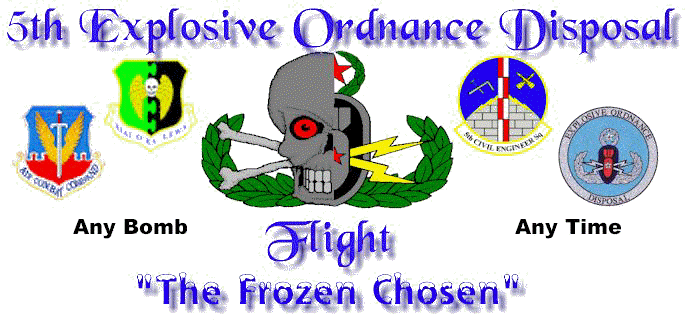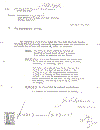
EOD Badge and Skull created by Christopher Pearce and James Jones
|
EOD Badge and Skull created by Christopher Pearce and James Jones |
|
|
"What is EOD?" The following extract from Air Force Instruction 36-2108 describes the US Air Force EOD career field: EXPLOSIVE ORDNANCE DISPOSAL 1. Specialty Summary. Performs, supervises, and manages explosive ordnance disposal (EOD) operations. Locates, identifies, disarms, neutralizes, recovers, and disposes of hazardous explosives; chemical, biological, incendiary, and nuclear ordnance; and criminal or terrorist devices. Related DoD Occupational Subgroup: 431. 2. Duties and Responsibilities:2.1. Conducts and supervises render safe operations. Responds to emergencies with equipment and technical data. Conducts long range and close in reconnaissance, identifies and accesses ordnance condition, and advises commanders on recommended safe withdrawal distances. Excavates and safes unexploded ordnance. Exploits unknown items for technical intelligence value. Uses monitoring and detecting equipment when ordnance may contain, or may be contaminated with, toxic or radioactive materials. 2.2. Disposes of unserviceable, excess, or dangerous ordnance. Transports demolition explosives and equipment to authorized disposal areas. Fabricates explosive demolition charges, and disposes of hazardous explosives according to environmental regulations and laws. 2.3. Neutralizes and disposes of improvised explosive devices. Uses x-ray equipment, robotics systems, and remotely initiated or controlled tools and techniques to interrogate and gain access to the device. Wears special protective bomb suit or armor. 2.4. Serves as a member of base emergency response team. Provides ability to detect, monitor, evaluate, and decontaminate explosive, radioactive, chemical, or biological ordnance hazards. Safes, removes, and disposes of ordnance from crashed aircraft or vehicles carrying explosives. 2.5. Restores airfield operations following enemy attack. Clears unexploded ordnance and hazards from airfields, forward operating locations, landing zones, and drop zones. 2.6. Clears explosive contaminated property. Surveys extent of explosive contamination on excess AF property, and on bombing and gunnery, research and development, and munitions test ranges. Prepares clearance plans and cost estimates for clearance operations. Establishes, operates, and maintains EOD explosive proficiency ranges. 2.7. Identifies requirements for and maintains tools, equipment, supplies, and technical data. Orders, inventories, stores, mobilizes, and maintains specialized tools, equipment, supplies, and EOD publications. Uses computers to support flight activities. Develops notional concepts, mission need statements, and operational requirements documents. 2.8. Plans EOD contingency operations. Develops operation plans, concepts of operation, and operating instructions on EOD employment. Develops explosive safety plans. 2.9. Supports special activities and taskings. Supports United States Secret Service, and other Federal agencies by providing protection to the President, Vice President, and other dignitaries. Deploys to support special operations and military operations other than war. Supports research and development testing of weapons, aircraft, and space systems. Supports specialized Joint Service task force operations. Provides EOD services to Federal, state, and local civil authorities. Instructs base and community members on ordnance recognition and protective measures for improvised explosive devices and conventional ordnance. Provides hazardous materials (HAZMAT) response capability for incidents involving explosive ordnance. 3. Specialty Qualifications: 3.1. Knowledge is mandatory of: composition and characteristics of United States and foreign conventional, chemical, biological, improvised, and nuclear ordnance; basic electronics; precautions, tools, and protective equipment required for response to release of hazardous substances as operations level first responders and level three technicians; and proper handling, use, rendering safe, and treatment of hazardous explosive wastes.About the EOD Badge
This terrific version of the EOD badge was created by SrA Boone Jarschke THE WREATH is symbolic of the achievements and laurels gained by minimizing accident potentials, through the ingenuity and devotion to duty of its members. It is in memory of the EOD personnel who have given their lives while performing EOD duties.THE BOMB was copied from the design of the World War II Bomb Disposal Badge, the bomb represents the historic and major objective of the EOD attack, the unexploded bomb. The three fins represent the major areas of nuclear, conventional, and chemical/biological warfare. THE LIGHTNING BOLTS symbolize the potential destructive power of the bomb and the courage and professionalism of EOD personnel in their endeavors to reduce hazards as well as to render explosive ordnance harmless. THE SHIELD represents the EOD mission which is to protect personnel and property in the immediate area from an inadvertent detonation of hazardous ordnance. A short history of Air Force EOD (Courtesy of NAVSCOLEOD. A comprehensive history of Navy EOD with lots of photos is here.) Bomb disposal in the United States dates back to April of 1941. EOD developed as an outgrowth of the British experience with German ordnance. The British Royal Navy dismantled/recovered the first German magnetic mine on the mudflats at Shoeburyness in 1939. The United States was not yet at war, but we were actively preparing for that eventuality. Embassy personnel and military observers were reporting on the actions of warring nations and as these reports were evaluated by the War Department Intelligence Section, recommendations were made concerning actions that should be taken by the U.S. One area stood out. Delayed-explosion bombs were creating havoc in Europe, taking a heavy toll in lives and industry. It was expected that if the U.S. entered the war, we would experience bombing of our cities and industries. As a result, the need for a bomb disposal program in this country received immediate attention. Click on this photo to see a great picture of British Bomb disposal during WWII. Picture courtesy of TSgt Bill Eaton.
In the beginning, it was thought that bomb disposal would be under the Office of Civilian Defense. In April 1941, the School of Civilian Defense was organized at the Chemical Warfare School, Edgewood Arsenal, Maryland, and part of the training was to be bomb disposal. The Commandant of the Chemical Warfare School assistance from the War Department to set up the Bomb Disposal School. The request was approved and forwarded to Gen. Julian S. Hatcher, who was the Commanding General of the Ordnance Training Center, Aberdeen Proving Ground, Maryland. Gen. Hatcher selected Maj. Thomas J. Kane to provide assistance.It was decided that both military and civilian bomb disposal personnel would be trained by the Army. All responsibility for bomb disposal was placed under the W.S. Army Ordnance Department. The Office of Civilian Defense would be responsible for bomb reconnaissance and the disposal of incendiaries in the U.S. The location of the Bomb Disposal School was changed from Edgewood Arsenal to the Ordnance Training Center, Aberdeen Proving Ground, Maryland. The newly promoted Colonel Kane was selected to be the school’s commandant. In the interim, the Navy, under a directive from the Chief of Naval Operations, instituted a Mine Disposal School in May of 1941. The school was located in Washington, D.C., and it was tasked with the training of Navy personnel in the disposal of U.S. and foreign mines and other underwater ordnance. In December if 1941, the Chief of Naval Personnel issued another directive for the formation of the Navy Bomb Disposal School. The Air force began EOD training as soon as they became a separate branch of the armed forces in 1947. On 21 May 1951, the Air Force assumed explosive ordnance disposal responsibilities and assigned EOD operational duties within the Zone of Interior (ZI) to Headquarters Air Material Command (HQ AMC). Accordingly, the AMC activated its first explosive ordnance disposal squadron, effective 16 June 1952, when the 1st Ordnance Squadron, Aviation, was redesignated as the 1st Explosive Ordnance Disposal Squadron, pursuant to authority contained in the HQ AMC General Order Number 29. Assignment was at Wright Patterson AFB, Ohio, with an authorized strength of 11 officers and 65 airmen. The 1st Explosive Ordnance Disposal Squadron was entitled to the history, battle honors, and any colors belonging to the 1st Ordnance Squadron, Aviation, deactivated 1 October 1948. On 24 November 1953, Headquarters, 1st Explosive Ordnance Disposal Squadron at Wright-Patterson AFB, Ohio, had eleven detachments in the United States which were responsible generally for EOD within an Air Force installation’s geographical area. These detachments performed emergency EOD work at the following locations:
1940, Training began for USA, USMC, USN at Melksham RAF Station, Wiltshire, England. 1941, School of Civilian Defense organized at Chemical Warfare School, Edgewood Arsenal, MD. Major Thomas J. Kane selected as Commandant. 1941, U.S. Naval Mine Disposal School established at Naval Gun Factory (NGF), Washington, DC. Eight volunteer graduates of Naval Mine Warfare School at Yorktown, VA transferred to NGF. 1941 (Aug), first class of S.S. Naval Mine Disposal School graduates. 1942, U.S. Army Bomb Disposal School organized at Ordnance Training Center, Aberdeen Proving Grounds, MD. 1942, Maj Kane, Commandant of Bomb Disposal School at Aberdeen, with 8 other officers and EM traveled to UK for training and familiarization. 1942, a UK bomb Disposal team brought a complete set of Bomb Disposal equipment to Aberdeen for demonstrations and training. 1942, first U.S. Army Bomb Disposal unit, the 231st Ordnance Bomb Disposal Company, was organized and deployed. 1942, the pocket or sleeve insignias, red bomb on a black background, was approved for U.S. Army wear by all Bomb Disposal officers and those Bomb Disposal EM actually assigned to Bomb Disposal units. 1942, the distinctive badge for the Ordnance Bomb Disposal School was approved by the Army and authorized for wear by all Bomb Disposal Officers and Disposal EM assigned to the school (click on thumbnails below to see the approving orders and original badge).    Click on these thumbnails to see photocopies
of the original orders authorizing the first US bomb disposal badge. Click on these thumbnails to see photocopies
of the original orders authorizing the first US bomb disposal badge.
1942 (Jan) U.S. Navy Bomb Disposal School formulated at American University Campus, Washington, DC. 1942, U.S. Bomb Disposal officers were assigned to the Pacific Theater. The 232nd Ordnance bomb Disposal Company was the first U.S. Army Bomb disposal unit in the Pacific theater of Operations. 1942, British bomb disposal units accomplished bomb disposal operations in first European allied operation involving U.S. Army. 1942, Ensign Howard, USNR, was the first U.S. casualty in mine disposal. He attempted to safe a booby trapped German magnetic submarine-laid moored mine. 1943, Army Bomb Disposal Division set up in England for support of U.S. bomb disposal operation in Europe. 1943, LT Rodger, USA and TSgt Rap, (5th ORD Bomb Disposal Squad) USA were the first Army Bomb Disposal Technicians to be killed (carrying out bomb disposal operations on Attu Island). 1943, a number of U.S. Army bomb disposal units experienced casualties while working on sea mines and other underwater ordnance for which they had received no training. 1943, U.S. Marine Corps began training at American University. 1945, U.S. Army Bomb Disposal Center at Aberdeen deactivated; training transferred to the Ordnance School, Aberdeen. 1946, U.S. Navy Mine and Bomb Disposal Schools combined at Bellevue Annex of Naval Gun Factory, then moved to Naval Powder Factory, Indian Head, MD on Jackson Road. Training course designated as Explosive Ordnance Disposal, giving birth to "EOD". 1947, U.S. Army Officer and Senior Enlisted started attending U.S. Navy EOD School. Junior Enlisted Army personnel continued training at Aberdeen, MD. 1947, U.S. Air Force became a separate service and began EOD training. 1947, Bureau of Naval Weapons designated the first Naval unit for the Research, Development, Test and Evaluation of EOD equipment at the USA naval Powder Factory. It was an integral part of the EOD School and later became the EOD Technology Center. 1949, All USA and USAR bomb disposal squads were redesignated as Explosive Ordnance Disposal (EOD) squads. 1950, 98th EOD Squad arrived in Korea, joined seven days later by the 19th EOD Squad. 1951, U.S. Navy assigned Joint-service EOD responsibilities for basic training and research and development. 1953, Research and Development tasks were established as a separate organization, and redesignated the Naval Explosive Ordnance Technical Center. The training function was renamed the Naval School, Explosive Ordnance Disposal (NAVSCOLEOD). 1954, U.S. Army Explosive Ordnance Disposal Center was established by General Order 181. 1955, U.S. Army EOD School at Aberdeen, MD officially closed. From this date on, all Joint Service EOD training has taken place at Indian Head, MD. 1956, Dept. of Army approved the design of the basic EOD badge, which became available for wear in 1957. 1958, NAVSCOLEOD moved to its present location on Strauss Ave. from the original site on Jackson Rd. 1960, Aberdeen Proving Ground Center (U.S. Army EOD Center) was moved to Picatinney Arsenal, Dover, NJ to be the focal point of munition development. 1962, Naval Explosive Ordnance Technical Center redesignated the Naval Explosive Ordnance Disposal Facility (NAVEODFAC), and placed under direction of a Commanding Officer. 1965, EOD units arrive in Vietnam. 1969, Master EOD Badge approved for wear by qualified personnel. 1969, (14 Feb), an EOD Memorial Committee was formed and consisted of Senior Army, Navy, Marine, and Air Force officers of NAVSCOLEOD. 1969, First EOD Memorial Ball held at NAVSCOLEOD, Indian Head, MD. 1970, (12 June), the EOD Memorial was dedicated to the men and women who have died on active duty as a result of an EOD mission since the declaration of World War II. 1971, EOD Memorial Scholarship Fund established. 1971, DoD Directive assigned the Secretary of the Navy as Single Manager for EOD Technology and Training. 1972, Patricia E. Brown, daughter of 1Lt Gilbert L. Brown, USMC (deceased), was awarded the first EOD Memorial scholarship. 1972, Procedural guidelines were established for the DoD EOD Program Board. 1977, Deputy Managers for EOD technology and EOD Training established (concurrent duty, respectively, for CO, NAVEODFAC and CO, NAVSCOLEOD). 1980, NAVEODFAC redesignated the Naval Explosive Ordnance Disposal Technology Center (NAVEODTECHCEN). 1985, U.S. Army Explosive Ordnance Disposal Center was renamed the EOD Office. 1985, (1 Oct) NAVSCOLEOD Detachment, Eglin AFB, FL established. 1986, (Oct) Construction began at NAVSCOLEOD Detachment Eglin. 1988, (24 June) NAVSCOLEOD Detachment, Eglin AFB officially opened. 1993, (Jul) NAVSCOLEOD command relocated to Eglin AFB; NAVSCOLEOD Indian Head designated as detachment. 1993, (Oct) NAVEODTECHCEN redesignated NAVEODTECHDIV, a division of the newly established Naval Ordnance Center. 1994, (Nov) CO and HQ NAVSCOLEOD return to Indian Head due to MILCON delays at Eglin AFB, FL. EOD School at Eglin redesignated as detachment. 1998 (fall), Construction of new interservice EOD school at Eglin AFB complete and NAVSCOLEOD to move to Eglin winter '99.A informative history of Air Force EOD's migration from the maintenance community into Civil Engineer can be found here http://www.afcesa.af.mil/AFCESA/Readiness/EOD/history/CEEOD4.html . Have something to add to this short history? Email us from our email link on the left or at the bottom. |
You are visitor
|